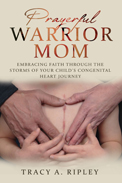
 |
Prayerful Warrior Mom: Embracing Faith Through the Storms of Your Child's Congenital Heart Journey
by Tracy A. Ripley
Using her faith as fuel, the author lays bare her soul in this raw and incredibly vulnerable chronicle of hope and fear. Rooted in scripture, the work and the themes presented within it are universal, depicting the human struggle to balance all aspects of their lives without losing themselves. For Ripley, a blessing in the form of baby Bryce is rife with obstacles, such as her child’s congenital heart disease (CHD), spearheaded by a faulty heart valve. The author’s unyielding tenacity, come what may, to ensure that Bryce is able to lead a quality life is something to truly marvel at.
Ripley’s blended family consists of her husband, Rob, two step-kids she adores, and her biological daughter, Reyna. The seamless environment allows the author to maintain a work-life balance and challenge herself at the apex of both motherhood and career. However, when Bryce is diagnosed with severe aortic stenosis a mere fourteen hours after birth and must be taken away for an emergency procedure, the reality of how grueling the process will be dawns on her. From her own testimony and resilience, audiences will discover their own inner spirit and mettle, a roadmap of sorts when battling similar adverse circumstances.
Though the main focus of Ripley’s work is to share Bryce’s journey to health, it also provides great detail and context into her overall life, pulling back the curtain, so to speak, for audiences to get a comprehensive snapshot. For instance, Ripley takes readers back to her own upbringing and how her parents were to add an extra layer of understanding of how she came to be who she is. In these segments of the piece, readers can easily relate to the hurdles women face in their careers, often feeling conflicted about the perception of their dedication and commitment to the company once they are mothers. For Ripley, commitment is central to her character, as even in the moments leading up to going into labor, she is training her backup to deliver a presentation for her job.
While the problems of the material world are undoubtedly well captured, it is the authenticity with which Ripley communicates her relationship with God that readers will find endearing. Rather than preach through scriptures, she shows how those scriptures have come to life for her, giving her a platform through which she can process and even see the silver lining in traumatic events, such as seeing her baby in the NICU just after birth, feeling disconnected from her child, or watching her now toddler continue to endure one heart surgery after another. Nonetheless, through it all, her trust in God remains unconditional, never wavering, and always enabling her to stay steadfast in prayer.
From a stylistic perspective, the story flows smoothly, creating an enjoyable reader experience while still delving into critical themes like work-life balance, ensuring the right medical fit when entrusting practitioners with your life or the life of a loved one, and the role of mothers in the workforce as compared to fathers. Above all else, audiences get to see how prayer directly impacts and enhances one’s quality of life and provides the tools for individuals to find love in all areas, such as in the Lord, in themselves, and in all those that make up their inner circle. To this end, Ripley’s work combines the resources of prayer—with her “7 Day Prayer Guide”—and CHD resources so families going through the same thing can have the tools to tackle life’s challenges head-on and become prayerful warriors themselves.
RECOMMENDED by the US Review
Next Focus Review
Previous Focus Review